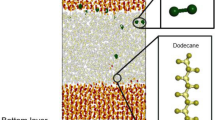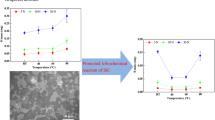Abstract
The purpose of this work was to establish the conditions for the operation and break-in of water-lubricated ceramic bearings. The experiments consisted of sliding 1/4″ silicon nitride or—carbide balls against pre-polished disks of the same material in water until tribochemical wear generates smooth conformal surfaces that allow hydrodynamic lubrication (μ<0.002) by very thin water films. This “running in” was performed at various sliding speeds (0.01-4m/s) and loads (0.5-20N). The minimum sliding speed for low friction were 0.04m/s for silicon nitride and 0.5m/s for silicon carbide, much lower than for conventional bearings. The load carrying pressures were 60-80MPa, which is higher than the usually pressures of thrust bearings. The hydrodynamic fluid film thickness was estimated with a standard integration of Reynolds' equations modified for circular geometry, it was to be 5-15nm for silicon nitride, 25nm for silicon carbide. Operation over long distances (80km) allowed us to measure the wear rate during hydrodynamic lubrication; this was found to be <2×10−11mm3/nm, a rate acceptable for industrial application. A novel method completed during this work allows the determination of the wear rate during run-in. It varies with sliding velocity for silicon nitride, from 1 to 6×10−5mm3/nm; it is constant at 4×10−6mm3/nm for silicon carbide.
Similar content being viewed by others
References
H. Tomizawa and T.E. Fischer, ASLE Trans. 30 (1987) 41.
S.R. Hah and T.E. Fischer, J. Eletcrochem. Soc. 145 (1998) 1708-1714.
S.R. Hah and T.E. Fischer, J. Electrochem. Soc. 146 (1999) 1505-1509.
V. Muratov and T.E. Fischer, Annu. Rev. Mater. Sci. 30 (2000) 27-51.
J. Xu, K. Kato and T. Hirayama, Wear 205 (1997) 55-63.
H.-C. Wong, N. Umehara and K. Kato, Wear 218 (1998) 237-243.
J. Xu and K. Kato, Wear 245 (2000) 61-75.
M. Chen, K. Kato and K. Adachi, Wear 250 (2001) 246-255.
M. Chen, K. Kato and K. Adachi, Tribol. Int. 35 (2002) 129-135.
X. Wang, K. Kato, K. Adachi and K. Aizawa, Tribol. Int. 36 (2003)189-197.
S.M. Hsu, Presentation at DARPA Conference on Steam Engines, Los Angeles, November 20, 2002.
V.A. Muratov, T. Luangvaranunt and T.E. Fischer, Tribol. Int. 31 (1998) 601-611.
V.A. Muratov and T.E. Fischer, ''Tribochemical Reactions of Silicon Nitride in Aqueous solutions '', Finishing Adv. Ceram Glasses p. 245-257.
Z. Zhu, V. Muratov and T.E. Fischer, Wear Mat. Intl. Conf., Wear 225-229 (1999) 848-856.
A. Cameron, Basic Lubrication Theory (J. Wiley, New York, 1976).
X.-Z. Zhao, J.-J. Liu and T.E. Fischer, Wear (1997).
T.E. Fischer and H. Tomizawa, Wear 105 (1985) 29.
H. Tomizawa and T.E. Fischer, ASLE Trans. 29 (1986) 481.
Rights and permissions
About this article
Cite this article
Jordi, L., Iliev, C. & Fischer, T.E. Lubrication of Silicon Nitride and Silicon Carbide by Water: Running in, Wear and Operation of Sliding Bearings. Tribology Letters 17, 367–376 (2004). https://doi.org/10.1023/B:TRIL.0000044485.77019.fb
Issue Date:
DOI: https://doi.org/10.1023/B:TRIL.0000044485.77019.fb




